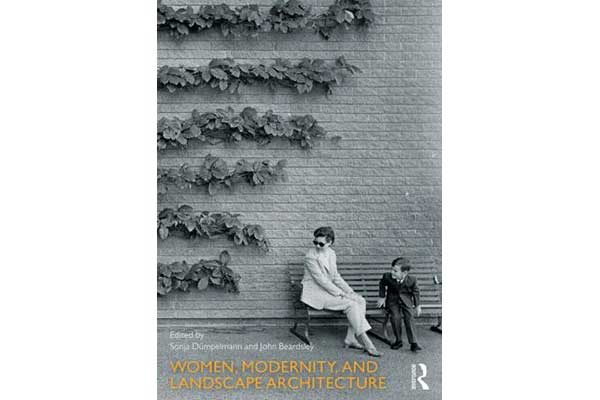
Editors: Sonja Dümpelmann and John Beardsley (Routledge, 2015)
During the through the Depression and Post-War eras, two coalescing movements—women joining the work force, and the rise of modernism as a formal language in environmental design—served as the backdrop for the young profession of landscape architecture.
Women, Modernity, and Landscape Architecture is a compilation of essays whose topics originate from a conference organized by the editors at the Harvard Graduate School of Design. The 10 articles contain an impressive amount of primary research to compose historical accounts of early female practitioners of landscape architecture in the developed world, in the context of these coalescing movements.
While the book avoids presenting the work and lives of it’s subjects as outright expressions of any feminist movement, it instead takes responsibility for documenting unwritten histories. The essays profile women relevant to the practice in their respective countries of the USA, Canada, Brazil, New Zealand, South Africa, the former USSR, Sweden, Britain, Germany, Austria, France and Italy, presenting resume and portfolio-style histories of the roles women played as teachers, practitioners, and advocates of landscape architecture, in their respective nations. While many of the women and projects profiled will never become household names, or as well known as those in current landscape architecture history classes, they exemplify the importance of presenting evidence of these roles, regardless of the presence of a blatant agenda.
The strongest essays of the compilation focus on single subjects of research, allowing the authors to explore specific projects and techniques used by the landscape architects in greater depth than list form, expanding on the relevance and importance of their formal choices in design, to their personal and career trajectories as women.
Both Kelly Comras‘ “Ruth Patricia Shellhorn: Mid-century living in the Southern California landscape” and Susan Herrington‘s “Cornelia Hahn Oberlander: A model modern” acknowledge the unique positions Shellhorn and Oberlander held as women landscape architects. Both authors are conscious not to attribute their successes, struggles, or relevance as designers to their femininity or by comparing them to male counterparts. Rather, both paint rich portraits of hard-working and intelligent designers who applied new formal techniques and ran successful practices of their own, making them both examples of modernity and modernism. Herrington elaborates:
Histories of design have described ‘modern’ as embodying male subjectivity. However, it has also been argued that within these histories the ‘modern woman’ has been a recurring theme as a sign of change. From the nineteenth-century suffragette to the liberated woman of the 1970s, the modern woman’s capacity to epitomize transformation has enabled her to uniquely represent an essential quality of modernity, that of change.
Oberlander’s family history of strong and well-educated women, and three children born while running her own practice, are presented alongside her use of abstraction, functionalism, and syncopation as design techniques to compose an image of a “model modern.” Likewise, Shellhorn’s designs for Bullock’s department store—spaces gendered female in the post-war era—wealthy female clientele and male mentorship are given equal weight to her role defining Southern Californian landscape design aesthetic on those respective projects.
Today, landscape architecture has grown to a much more gender-balanced field than in Oberlander and Shellhorn’s days. The 2015 CSLA compensation and benefits study suggests landscape architecture is a promising field for women today in Canada, with a 41% female to 59% male composition, and younger generations at near-balanced numbers in the workforce and in accredited programs. As we move forward with new histories, Women, Modernity, and Landscape Architecture reminds us how important it is to also keep writing the past.
***
If you want more information on Women, Modernity, and Landscape Architecture, visit the Routledge website.
**
Shelley Long is a landscape designer interested in cross-disciplinary collaboration in environmental design, Canadiana, and placemaking through spacemaking.


